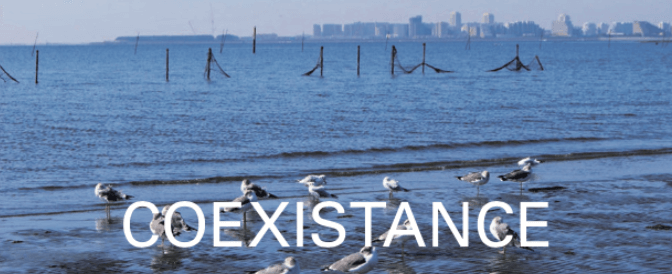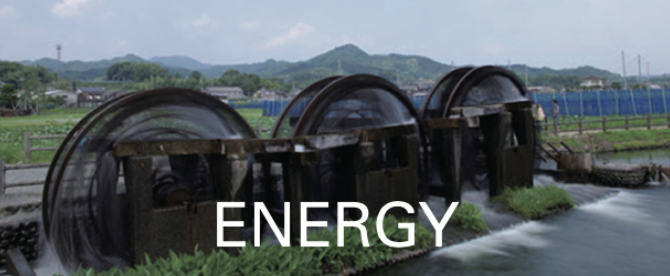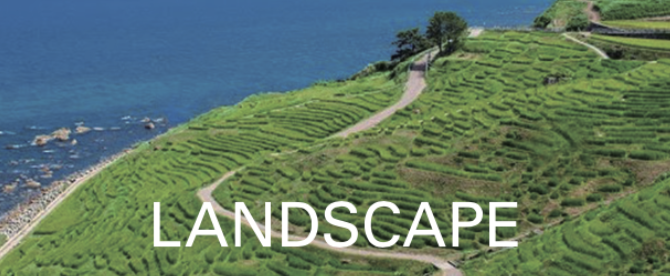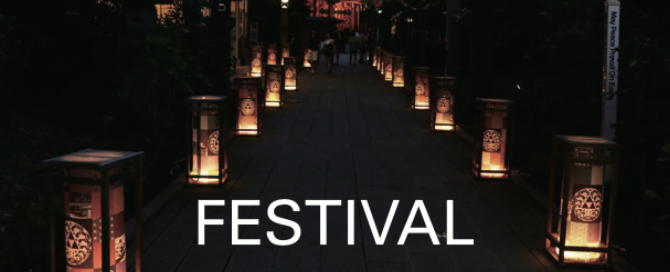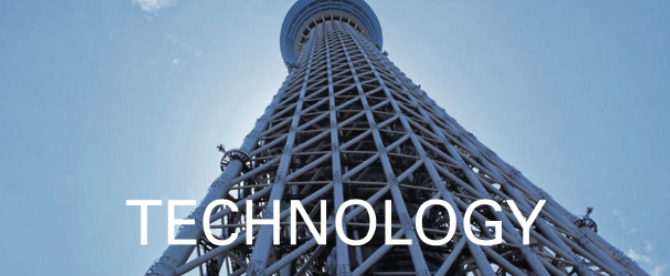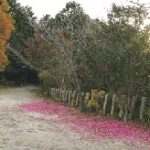
Mt. Kannabiyama(217m) is the mountain that straddles Kyoto and Osaka prefectures. It was also said that Suzaku Boulevard, the main street of Heiankyo the ancient capital of Kyoto, was built as a line connecting this mountain with Mt. Funaoka (111m), in northwestern Kyoto.
Shikinaikannabi shrine, near the top of the mountain, appeared in Konjaku Monogatarishu, the Anthology of Tales from the Past in the late Heian period in the 11th – 12th centuries. Tsutsuki no miya, the Palace of Emperor Keitai in the 6th century, was around this shrine. It was mentioned at the Kojiki, the records of Japanese Ancient Matters and Nihonshoki, the Chronicles of Japan, in the 8th century.
The whole area of this mountain is a forest park where you can enjoy the beautiful scenery of each season and the view from Yawata City to the urban area of Kyoto.
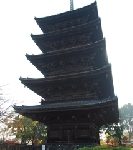
In 823, Kobo Daishi Kukai (774 – 835), the founder of the Shingon sect, received Toji Temple from Emperor Saga (786 – 842) and made it the central training center of Shingon Esoteric Buddhism.
Yakushi Nyorai, the Buddha of Healing, for the welfare of the State, is enshrined in the Kondo, the main hall of a Buddhist temple. Dainichi Nyorai, Supreme Buddha of the Cosmos and the central object in Esoteric sects of Buddhism, and the statues of the images of Esoteric Buddhism, are enshrined in the Kodo, a lecture hall.
The five-storied pagoda resembles the main pillar as Dainichi Nyorai, and enshrines 4-Nyorai, Buddhas of the Diamond Realm, and the Great 8-Bosatsu, Bohhisattvas that save people with Mercy, on Shumidan, an altar of a Buddhist image, around the main pillar.
This pagoda has never collapsed by any earthquakes, as it was built with a flexible structure in each layer and is not stacked nor tightly bound. Because the restoring force is superior to the self-destructing force.

Hozugawa River runs from the Tanba Mountains in the center of Kyoto Prefecture through Sonobe and Kameoka to the Katsura River in Arashiyama, and joins the Kamo River to reach the Yodo River.
The Gorge of the Hozugawa River had sustained the Heiankyo Capital of Kyoto, to supply goods since old days. The wood was delivered by rafts on the Hozu River, and unloaded at Arashiyama, which connected the Kyoto Imperial Palace through Marutamachi-dori Street, which ran east to west.
The rafts of the Hozugawa River changed Takasebune, a flatboat, in the development of the Hozukyo Gorge, in the Keicho era (1596 – 1615) of the Edo period. This change was led by Suminokura Ryoi (1554 – 1614), a wealthy merchant and shipper of overseas trade.
—The sightseeing boat ride was first introduced in the 1890s.
Now you can enjoy the beauty of the unique rocks and megaliths while riding on the Usen, a sightseeing boat, instead of the Takasebune.
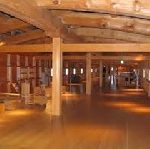
Maeda Toshiie (1538 – 1599): the founder of Kaga Domain and Dainagon, the Great Counselor, took a group of craftsmen to Kanazawa to construct the Kanazawajo Castle.
A timber framework method combined pillars, beams, wood girders, and a wood wedge, rather than using iron nails nor bolts. The bearing wall, which combines earthen walls, and Nuki, poles between pillars, is an extremely durable structure that is earthquake resistant.
Traditional techniques are inherited through restoration work, such as Hishi Yagura (a watchtower to observe both the front gate and the rear gate).
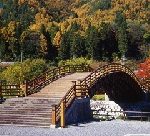
This bridge over the limpid stream of the Narai River, originated from Mt. Kiso Komagatake. It is a symbol of a dream in a new era, conceived of during the Heisei period (1989 – 2019). It is a beautiful all-cypress Taikobashi, an arched bridge with no stanchions, which connects the “Michino-eki, roadside station Narai” and the vast grassy waterside park.
It represents the history of Narai which was the mid post town on the Nakasendo, the route connecting Kyoto and Edo in the Edo period (1603 – 1868). It is where the woodwork of Magemono, a round-shaped Japanese box made of thin strips of wood, comb and lacquer ware, thrived.
This bridge (as a big Magemono) is lit up after sunset from early April to early November.
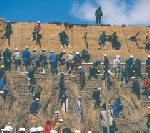
The Gassho Style Houses: a house with a steep rafter roof, of Shirakawa-go consists of two structures: the house framework and the roof frame. The house framework, including pillars, girders, beams etc, are handcrafted by groups of craftsmen, such as the Ookubo carpenters of the Kaga Domain and the Hida craftworkers.
The roof frame was handled by Shirakawago villagers. The steep sloping roof let the snow to fall easily off, and the dual structure escapes the force hit by the wind and the earthquake. The roof gable surface of the triangle turns aside the valley wind.
Pearls of wisdom are alive now, even after 400 years.
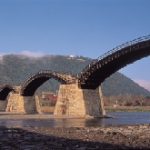
The bridge connecting Iwakunijo Castle and the castle town used to be frequently washed away by the flooding of the Nishikigawa River. Dokuryu Shoeki (1596 – 1672) was a Zen monk of the Obaku sect in China, and became a naturalized monk. He guided the lord of Iwakuni Domain about the six arched bridges that spanned the islands of Sai Lake, Sung China.
On accumulating this wisdom and effort, the basic concept of this bridge came out. That was – the sub-structure of the wooden arch bridge was strengthened with stone walls, and the arch bridge was designed to be curved to make uniform the mass density at its vertexes. Then, the bridge has been replaced every 20 years.

You can enjoy 360 degree panoramic views at Yatakayama Park at an altitude of 654m. Mt. Yatakayama was made 2.5 million years ago, and the rocks were hard and could have survived many years of encroachment.
You can see Mt. Gagyusan (about 480m) and Bicchu Matsuyamajo Castle from the top of the mountain. Bicchu Matsuyamajo Castle is the highest mountain castle to have a castle tower in Japan. This castle was renovated and reconstructed by Kobori Enshu (1579 – 1647), a feudal lord, a master of the tea ceremony, an architect and garden designer, and his son.
The greatest image is seeing Enshua’s fine castle, floating in the early morning sea of clouds.

This museum is located between the Yoshino River and the Iya River, which is the Miyoshi City Important Tangible Cultural Property and introduces Horikawa Naiki. When the Taira clan exiled from the Capital of Kyoto, he escaped to Yashima Kagawa, with Emperor Antoku (1178 – 1185).
After the Downfall of the Taira clan, he entered the mountains of Iya with fugitives. The mother of Emperor Antoku was Kenreimon-in Tokuko (1155 – 1213), Empress of Emperor Takakura (1161 – 1181), and the daughter of Taira no Kiyomori (1118 – 1181), a head of the Taira clan, who established the first samurai dominated administrative government in Japan.
The Taira clan helped Emperor Antoku assume the throne. Naiki had served Emperor Antoku as the imperial court doctor, at the Imperial Palace.
The fact that they could have overcome the rough natural environment, which was completely different from the refined environment of the court, depended on his supple insights.
-This museum is currently run by the Nishioka family, which is the successive family of Naiki
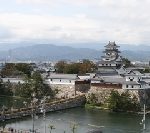
This castle was built in 1602 by Todo Takatora (1556 – 1630), a feudal lord and excellent castle designer, as a water castle to be entered by boat directly from the sea to the moat. This castle is on a beach hill, with a moat with three ditches.
This castle has the scaffolding named Inubashiri, a narrow and long path between the moat and stone wall which was made for the improvement of soft ground. This castle was designed to reveal the mastery of Seto Inland Sea and to build the wealth, rather than its defense.
It is now illuminated by lighting designer, Mr. Kaito Haruki.
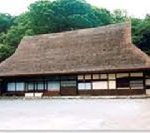
This was the residence of Shoya, a village headman, in the Tenjin district of the former Sogawamura Village, Seiyo City. It was a post station on a main road between Iyo Province Ehime and Tosa Province Kochi. It was built in 1827, in the latter part of the Edo period (1603 – 1868).
It is the largest and the oldest Kyabuki Minka, thatched house, on Shikoku Island. It is a valuable historical heritage which stands in the background of a hundred-year-old forest surrounding a residence, using a wooden framework structure method.
This heritage tells something about the Doi family who had served as Shoya, over 10 generations here.

This dike is the weir used to draw the river water into the irrigation canal. This destitute area was called the Skylark nest.
Fujie Kenmotsu (1687 – 1731), the chamberlain of the Nobeoka Domain, Hyuga Province Miyazaki, transformed this area to fertile land by the river conservation work, over 10 years, which combined flood prevention and an irrigation canal.
As a result, the yield rose from 150 koku to 766 koku, a unit volume for rice. There was water, but just no adjustment.
